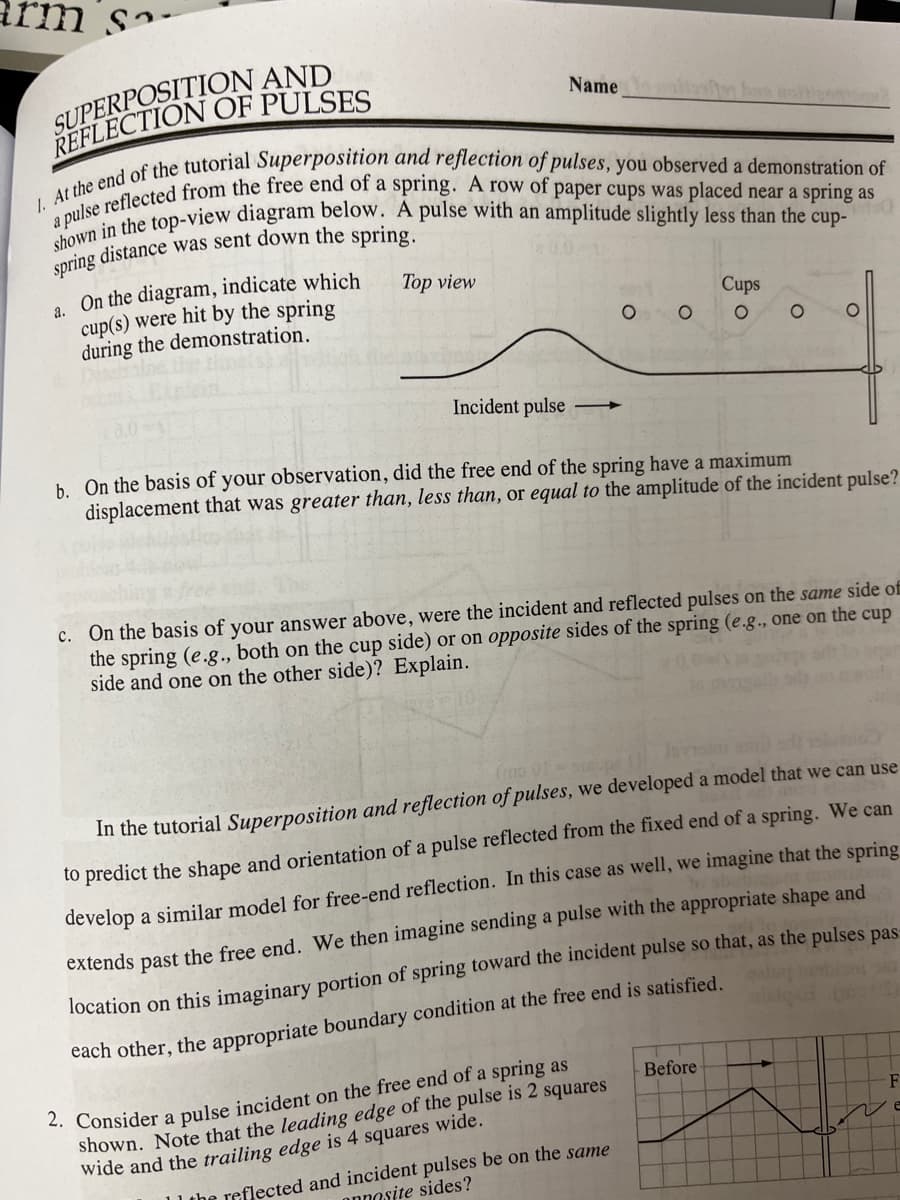RE a coring distance was sent down the spring. a. On the diagram, indicate which cup(s) were hit by the spring during the demonstration. Top view Cups Incident pulse b. On the basis of your observation, did the free end of the spring have a maximum displacement that was greater than, less than, or equal to the amplitude of the incident pulse? On the basis of your answer above, were the incident and reflected pulses on the same side of the spring (e.g., both on the cup side) or on opposite sides of the spring (e.g., one on the cup side and one on the other side)? Explain. с.
RE a coring distance was sent down the spring. a. On the diagram, indicate which cup(s) were hit by the spring during the demonstration. Top view Cups Incident pulse b. On the basis of your observation, did the free end of the spring have a maximum displacement that was greater than, less than, or equal to the amplitude of the incident pulse? On the basis of your answer above, were the incident and reflected pulses on the same side of the spring (e.g., both on the cup side) or on opposite sides of the spring (e.g., one on the cup side and one on the other side)? Explain. с.
Introductory Circuit Analysis (13th Edition)
13th Edition
ISBN:9780133923605
Author:Robert L. Boylestad
Publisher:Robert L. Boylestad
Chapter1: Introduction
Section: Chapter Questions
Problem 1P: Visit your local library (at school or home) and describe the extent to which it provides literature...
Related questions
Question
1a-1c please!

Transcribed Image Text:arm s-
SUPERPOSITION AND
REFLECTION OF PULSES
Name tn h
On the diagram, indicate which
cup(s) were hit by the spring
during the demonstration.
а.
Top view
Cups
Incident pulse
b. On the basis of your observation, did the free end of the spring have a maximum
displacement that was greater than, less than, or equal to the amplitude of the incident pulse?
c. On the basis of your answer above, were the incident and reflected pulses on the same side of
the spring (e.g., both on the cup side) or on opposite sides of the spring (e.g., one on the cup
side and one on the other side)? Explain.
In the tutorial Superposition and reflection of pulses, we developed a model that we can use
to predict the shape and orientation of a pulse reflected from the fixed end of a spring. We can
develop a similar model for free-end reflection. In this case as well, we imagine that the spring
extends past the free end. We then imagine sending a pulse with the appropriate shape and
location on this imaginary portion of spring toward the incident pulse so that, as the pulses pas:
each other, the appropriate boundary condition at the free end is satisfied.
2. Consider a pulse incident on the free end of a spring as
shown. Note that the leading edge of the pulse is 2 squares
wide and the trailing edge is 4 squares wide.
Before
11 the reflected and incident pulses be on the same
onnosite sides?
Expert Solution
This question has been solved!
Explore an expertly crafted, step-by-step solution for a thorough understanding of key concepts.
This is a popular solution!
Trending now
This is a popular solution!
Step by step
Solved in 2 steps

Knowledge Booster
Learn more about
Need a deep-dive on the concept behind this application? Look no further. Learn more about this topic, electrical-engineering and related others by exploring similar questions and additional content below.Recommended textbooks for you

Introductory Circuit Analysis (13th Edition)
Electrical Engineering
ISBN:
9780133923605
Author:
Robert L. Boylestad
Publisher:
PEARSON

Delmar's Standard Textbook Of Electricity
Electrical Engineering
ISBN:
9781337900348
Author:
Stephen L. Herman
Publisher:
Cengage Learning

Programmable Logic Controllers
Electrical Engineering
ISBN:
9780073373843
Author:
Frank D. Petruzella
Publisher:
McGraw-Hill Education

Introductory Circuit Analysis (13th Edition)
Electrical Engineering
ISBN:
9780133923605
Author:
Robert L. Boylestad
Publisher:
PEARSON

Delmar's Standard Textbook Of Electricity
Electrical Engineering
ISBN:
9781337900348
Author:
Stephen L. Herman
Publisher:
Cengage Learning

Programmable Logic Controllers
Electrical Engineering
ISBN:
9780073373843
Author:
Frank D. Petruzella
Publisher:
McGraw-Hill Education

Fundamentals of Electric Circuits
Electrical Engineering
ISBN:
9780078028229
Author:
Charles K Alexander, Matthew Sadiku
Publisher:
McGraw-Hill Education

Electric Circuits. (11th Edition)
Electrical Engineering
ISBN:
9780134746968
Author:
James W. Nilsson, Susan Riedel
Publisher:
PEARSON

Engineering Electromagnetics
Electrical Engineering
ISBN:
9780078028151
Author:
Hayt, William H. (william Hart), Jr, BUCK, John A.
Publisher:
Mcgraw-hill Education,